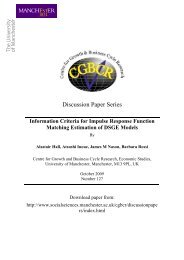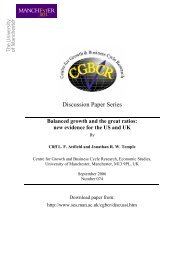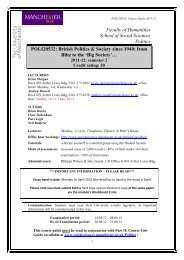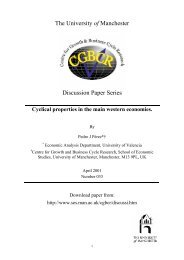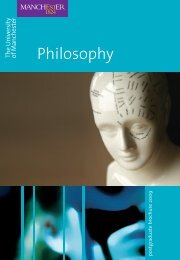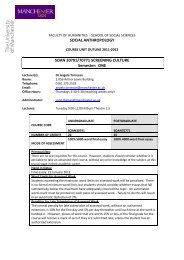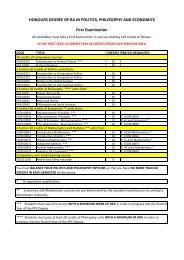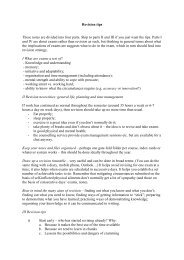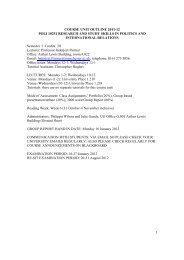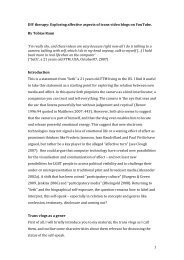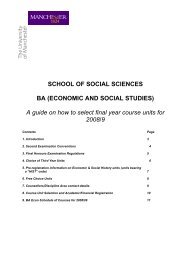CHNN 22, Spring 2008 - School of Social Sciences
CHNN 22, Spring 2008 - School of Social Sciences
CHNN 22, Spring 2008 - School of Social Sciences
Create successful ePaper yourself
Turn your PDF publications into a flip-book with our unique Google optimized e-Paper software.
Concluding Remarks<br />
Without further investigation, it is impossible to draw conclusions from these figures. But it is<br />
tempting to speculate. One speculation is this; that the decline in membership figures after the<br />
mid-1970s may have been largely generational. The fall does not seem to have related directly to<br />
political events (like 1968 – or even, in the long term, 1956); but it could be credibly explained by<br />
mortality. If many members had joined in the 1930s and early 1940s (aged, perhaps, in their early<br />
twenties), 4 and if that group represented the core <strong>of</strong> the loyal membership <strong>of</strong> the party, the sad<br />
truth is, that by 1975, it is actuarially probable that they would have started to die, in increasing<br />
numbers. Given mortality rates for manual workers, who made up much <strong>of</strong> the party’s core<br />
membership, especially in the large industrial districts, a sharp decline in membership in those<br />
areas could have been accounted for by mortality alone, especially for men aged 65 and over. (If, by<br />
contrast, many <strong>of</strong> the doughty Cornish and Devonian members were drawn from middle-class<br />
groups such as teachers, with higher life expectancies, the relative out-performance <strong>of</strong> the West<br />
Country in terms <strong>of</strong> membership retention, might also be partly explained.) Similar patterns –<br />
though this is not an analogy that would have appealed to the party – can be seen in the 1970s’<br />
sales figures for soap-powders, where old brands (adopted by consumers early in their married<br />
lives) were, by 1976, dying along with their loyal users. 5<br />
Harold Carter, St John’s College, Oxford<br />
haroldcarter@mac.com<br />
Gabriel Silkstone-Carter, Gonville and Caius College, Cambridge<br />
Harold Carter is working on the changing political economy British cities between 1945 and the present day;<br />
he is especially interested in the political and social impact <strong>of</strong> fifty years <strong>of</strong> social-democratic intervention in<br />
housing and planning, in the context <strong>of</strong> de-industrialisation. As part <strong>of</strong> this project he has written detailed<br />
histories <strong>of</strong> Southwark and <strong>of</strong> Sheffield, and he is currently working on the rise <strong>of</strong> the left in Sheffield before<br />
1984. Gabriel Silkstone-Carter is writing on the role <strong>of</strong> the Communist Party in the 1972 Miners' Strike in<br />
Kent. They would be very interested to hear from anyone with information (especially personal<br />
reminiscences) relating to these topics.<br />
Notes<br />
1 All our sources are loose documents in the box CP/CENT/ORG/19 (folders /01 to /04), in the Communist<br />
Party Archive in the People’s History Museum Manchester. There is an un-sourced part typed and part<br />
handwritten document, in folder 19/04 <strong>of</strong> that box, which gives annual membership totals for the party but<br />
no regional breakdown; these totals cross-check with the figures we report. The maximum divergence<br />
between the two totals is 5% <strong>of</strong> the total membership (in 1957), and the figures for other years agree closely.<br />
On 10 occasions the divergence is 2% or less, and on two others it is 3%.<br />
2 We have also reported numerically, though not graphically, three bench-mark years (1945, 1955, and 1957)<br />
because rather comprehensive data are available for those years (and we would like to draw attention to<br />
them), and because 1945 in particular represented a strong year for party membership (presumably, partly<br />
reflecting the popularity <strong>of</strong> the USSR as a wartime ally, and partly reflecting the continuing political activity<br />
<strong>of</strong> the CPGB at a time when Labour Party activism was muted by the exigencies <strong>of</strong> war).<br />
3 In the graphs, 1987 has been inserted as an average <strong>of</strong> 1985 and 1989, since no data were available in the<br />
file for 1986, 1987, or 1988. The graphs are available in coloured-in form (which is easier to read) in the<br />
online version <strong>of</strong> the Newsletter.<br />
4 Party membership peaked, at 56,000, in 1942, according to the unsourced document in file<br />
CP/CENT/ORG/19/04, which we have no reason to believe to be inaccurate.<br />
5 Author’s notes; presentation by Proctor and Gamble Ltd, Newcastle, 1975.<br />
21



